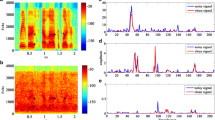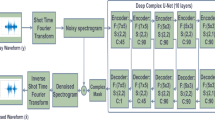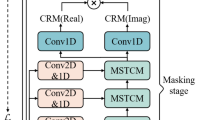Abstract
Aiming at the difficulty of data collection in the actual speech communication countermeasure and the lack of research on the disturbed speech in the strong jamming environment, in this paper, we study the estimation method based on the difference of domain distribution and category for small samples of speech under strong interference. By aligning the edge distribution and conditional distribution of the source domain and the target domain, the purpose of improving the evaluation accuracy in the case of small samples is achieved. The method first converts the interfering speech into a mel cepstrum, then uses a convolutional neural network to automatically extract features, and then evaluates small sample data by aligning the marginal distributions of the two domains. The experimental results show that the small sample evaluation model based on domain distribution differences can reach 82% on the target domain data set and 79% on the source domain data set, the small-sample evaluation model based on category differences can achieve an evaluation accuracy of 87% on the source domain data set, and the target domain data The set can reach 85%. Compared with the evaluation model on small samples, the accuracy rate is increased by 29%, which effectively solves the problem of evaluating the effect of voice communication interference in the case of small samples.














Similar content being viewed by others
References
Ma, M., Li, Z., Lin, Y., Chen, L., & Wang, S. (2020) Modulation classification method based on deep learning under non-gaussian noise. In: 2020 IEEE 91st Vehicular Technology Conference (VTC2020-Spring), pp. 1–5. https://doi.org/10.1109/VTC2020-Spring48590.2020.9129576. IEEE
Hou, C., Liu, G., Tian, Q., Zhou, Z., Hua, L., & Lin, Y. (2022). Multisignal modulation classification using sliding window detection and complex convolutional network in frequency domain. IEEE Internet of Things Journal, 9(19), 19438–19449. https://doi.org/10.1109/JIOT.2022.3167107
Tu, Y., Lin, Y., Hou, C., & Mao, S. (2020). Complex-valued networks for automatic modulation classification. IEEE Transactions on Vehicular Technology, 69(9), 10085–10089. https://doi.org/10.1109/TVT.2020.3005707
Avila, A.R., Gamper, H., Reddy, C., Cutler, R., Tashev, I., & Gehrke, J. (2019). Non-intrusive speech quality assessment using neural networks. In: ICASSP 2019-2019 IEEE international conference on acoustics, speech and signal processing (ICASSP), pp. 631–635. https://doi.org/10.1109/ICASSP.2019.8683175. IEEE
Soni, M. H., & Patil, H. A. (2016) Novel deep autoencoder features for non-intrusive speech quality assessment. In: 2016 24th European signal processing conference (EUSIPCO), pp. 2315–2319. https://doi.org/10.1109/EUSIPCO.2016.7760662. IEEE
Fu, S.-W., Tsao, Y., Hwang, H.-T., & Wang, H.-M. (2018) Quality-net: An end-to-end non-intrusive speech quality assessment model based on blstm. arXiv preprint arXiv:1808.05344. https://doi.org/10.48550/arXiv.1808.05344
Hao, M., & Wang, S. (2021) Evaluation of interference effect of speech communication system. In: 2021 13th international symposium on antennas, propagation and EM Theory (ISAPE), pp. 1–3. IEEE
Mittag, G., & Möller, S. (2019) Non-intrusive speech quality assessment for super-wideband speech communication networks. In: ICASSP 2019-2019 IEEE international conference on acoustics, speech and signal processing (ICASSP), pp. 7125–7129. IEEE
Mittag, G., Naderi, B., Chehadi, A., & Möller, S. (2021) Nisqa: A deep cnn-self-attention model for multidimensional speech quality prediction with crowdsourced datasets. arXiv preprint arXiv:2104.09494. https://doi.org/10.48550/arXiv.2104.09494
Li, X., Ma, W., Zhou, Z., & Xu, C. (2020) Xss attack detection model based on semi-supervised learning algorithm with weighted neighbor purity. In: Ad-Hoc, Mobile, and Wireless Networks: 19th international conference on ad-hoc networks and wireless, ADHOC-NOW 2020, Bari, Italy, October 19–21, 2020, Proceedings 19, pp. 198–213. https://doi.org/10.1007/978-3-030-61746-2_15. Springer
Serrà, J., Pons, J., & Pascual, S. (2021) Sesqa: Semi-supervised learning for speech quality assessment. In: ICASSP 2021-2021 IEEE international conference on acoustics, speech and signal processing (ICASSP), pp. 381–385. https://doi.org/10.1109/ICASSP39728.2021.9414052. IEEE
Wang, S., Lin, Y., Hao, M., Xu, H., & Tian, Q. (2022). Interference quality assessment of speech communication based on deep learning. IEEE Transactions on Reliability, 71(2), 1011–1021. https://doi.org/10.1109/TR.2022.3160587
Cai, Z., Ma, W., Wang, X., Wang, H., & Feng, Z. (2022). The performance analysis of time series data augmentation technology for small sample communication device recognition. IEEE Transactions on Reliability. https://doi.org/10.1109/TR.2022.3178707
Dong, Y., Jiang, X., Zhou, H., Lin, Y., & Shi, Q. (2021). Sr2cnn: Zero-shot learning for signal recognition. IEEE Transactions on Signal Processing, 69, 2316–2329. https://doi.org/10.1109/TSP.2021.3070186
Wang, M., Lin, Y., Tian, Q., & Si, G. (2021). Transfer learning promotes 6g wireless communications: Recent advances and future challenges. IEEE Transactions on Reliability, 70(2), 790–807. https://doi.org/10.1109/TR.2021.3062045
Goodfellow, I., Pouget-Abadie, J., Mirza, M., Xu, B., Warde-Farley, D., Ozair, S., Courville, A., & Bengio, Y. (2020). Generative adversarial networks. Communications of the ACM, 63(11), 139–144.
Ganin, Y., Ustinova, E., Ajakan, H., Germain, P., Larochelle, H., Laviolette, F., Marchand, M., & Lempitsky, V. (2016). Domain-adversarial training of neural networks. The Journal of Machine Learning Research, 17(1), 2030–2090.
Yu, C., Wang, J., Chen, Y., & Huang, M. (2019) Transfer learning with dynamic adversarial adaptation network. In: 2019 IEEE international conference on data mining (ICDM), pp. 778–786. https://doi.org/10.1109/ICDM.2019.00088. IEEE
Wang, Y.-Y., Gu, J.-M., Wang, C., Chen, S.-C., & Xue, H. (2020). Discrimination-aware domain adversarial neural network. Journal of Computer Science and Technology, 35(2), 259–267.
Ya, T., Yun, L., Haoran, Z., Zhang, J., Yu, W., Guan, G., & Shiwen, M. (2022). Large-scale real-world radio signal recognition with deep learning. Chinese Journal of Aeronautics, 35(9), 35–48. https://doi.org/10.1016/j.cja.2021.08.016
Lin, Y., Tu, Y., Dou, Z., Chen, L., & Mao, S. (2020). Contour stella image and deep learning for signal recognition in the physical layer. IEEE Transactions on Cognitive Communications and Networking, 7(1), 34–46. https://doi.org/10.1109/TCCN.2020.3024610
Acknowledgements
This work is supported by the National Natural Science Foundation of China (No: 62201172), the National Key Research and Development Program of China (2022YFE0136800). This work is also supported by Key Laboratory of Advanced Marine Communication and Information Technology, Ministry of Industry and Information Technology, Harbin Engineering University, Harbin, China.
Author information
Authors and Affiliations
Corresponding author
Additional information
Publisher's Note
Springer Nature remains neutral with regard to jurisdictional claims in published maps and institutional affiliations.
Rights and permissions
Springer Nature or its licensor (e.g. a society or other partner) holds exclusive rights to this article under a publishing agreement with the author(s) or other rightsholder(s); author self-archiving of the accepted manuscript version of this article is solely governed by the terms of such publishing agreement and applicable law.
About this article
Cite this article
Wang, S., Lin, Y., Hao, M. et al. Assessment of speech communication interference effects under small sample conditions. Wireless Netw 29, 2909–2923 (2023). https://doi.org/10.1007/s11276-023-03396-4
Accepted:
Published:
Issue Date:
DOI: https://doi.org/10.1007/s11276-023-03396-4




